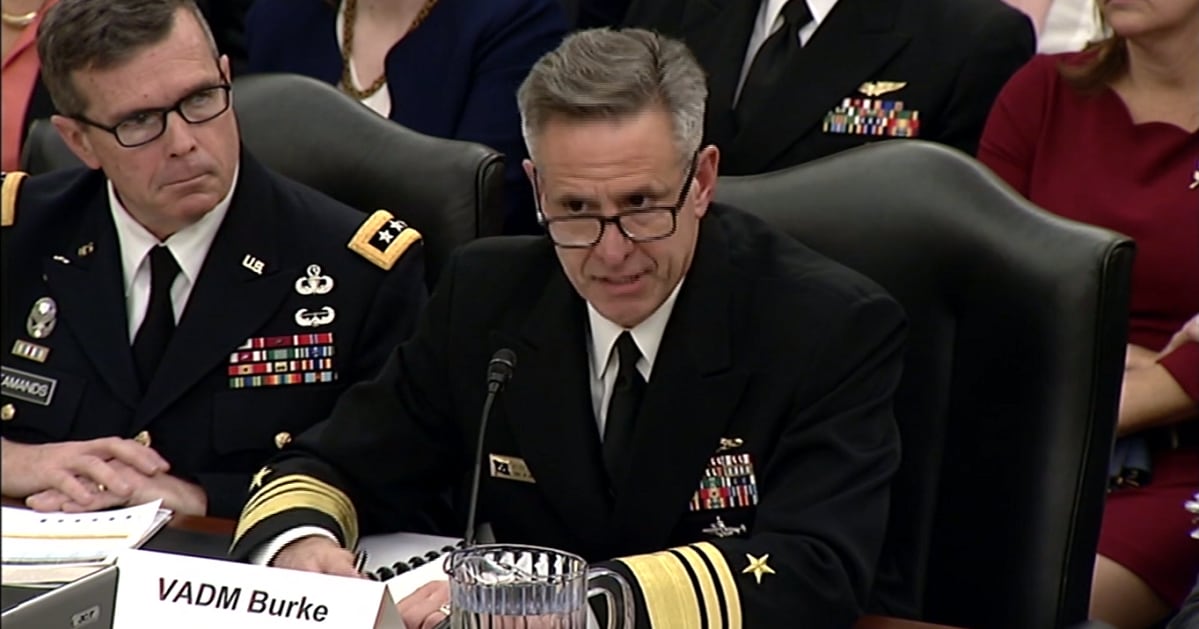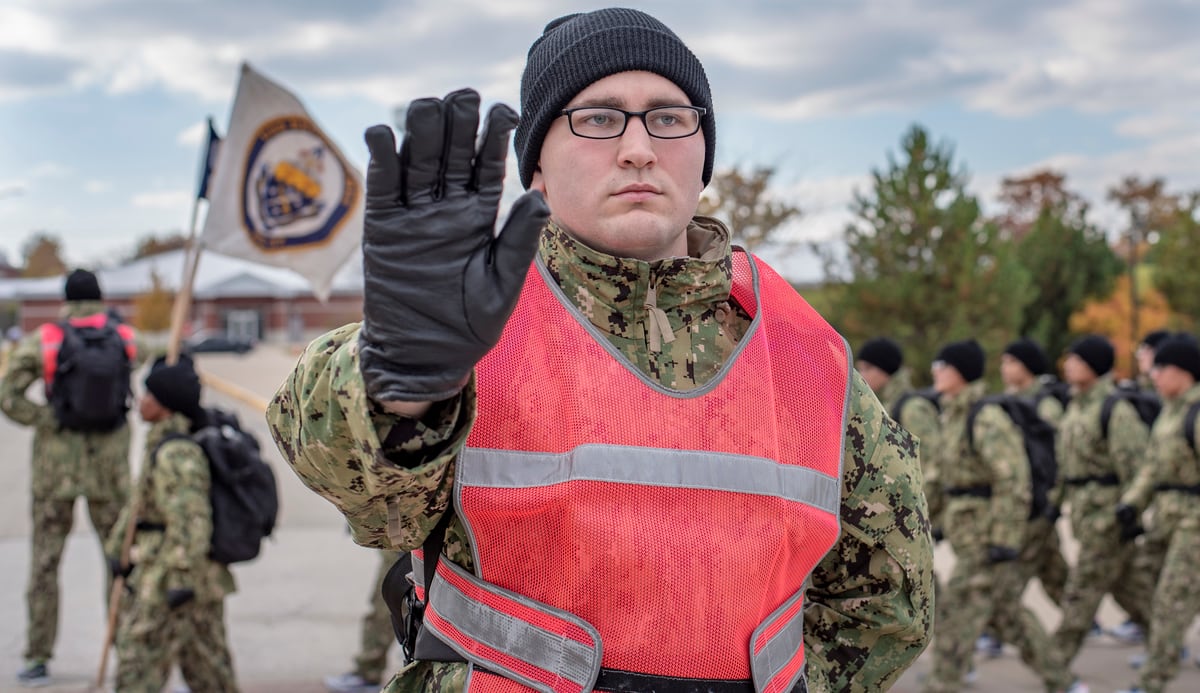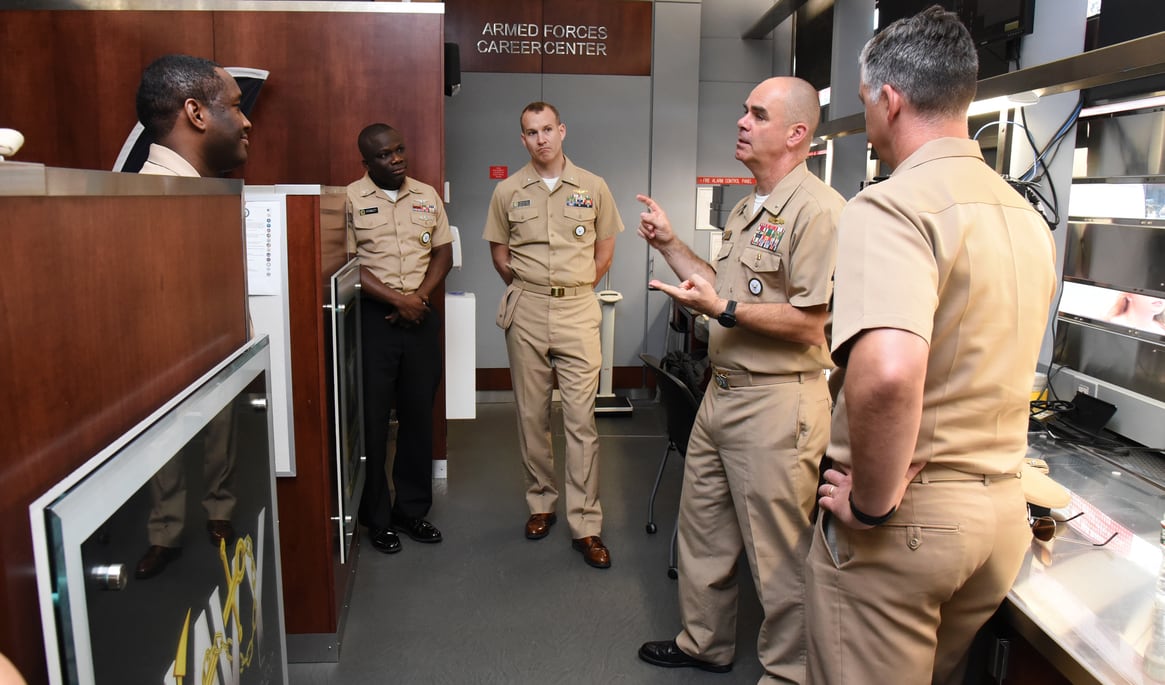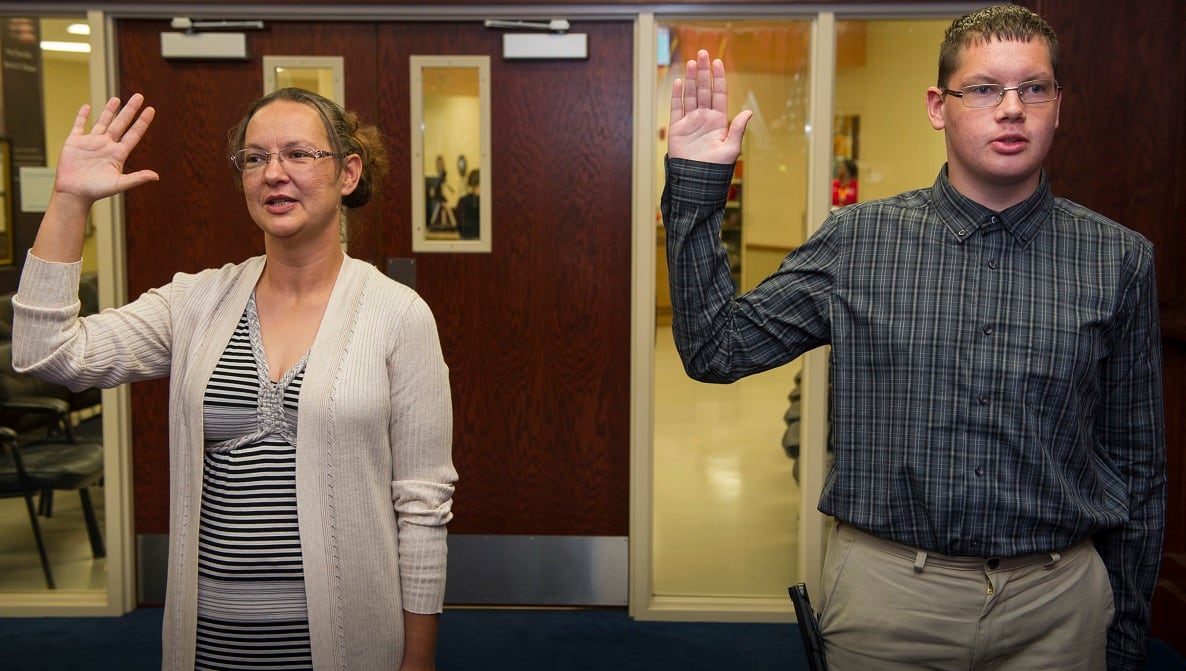A new era is dawning in great power competition, with the Navy preparing to fight a large-scale war at sea. But to win a great sea battle, the Navy’s leaders first must win the homefront battle for the best recruits.
“We are clearly in a war for talent,” Vice Adm. Robert Burke, the Navy’s top personnel official, told Congress earlier this year. “Current forecasts based on leading economic indicators suggest difficult times ahead.”
A dynamic economy not only deters some teenagers from enlisting in the Navy but it attracts sailors away from the fleet and into the civilian workforce. Although Burke said the Navy’s enlistment efforts are shipshape for now, his service is taking steps to expand the potential pool of recruits.
Burke is revamping the service’s recruiting policies, ramping up the numbers or recruiters in the field and expanding heavily into cyber-recruiting young digital natives online.
Navy leaders have hiked enlistment bonuses and continue to scrub medical requirements to scrap outdated policies that might block otherwise good recruits from enlisting.
Navy officials say that retention is a key part of their manpower strategy, too. And for those who do leave, the Navy is looking for ways to entice them back into uniform.
Those challenges are compounded by the Navy’s drive to build a 355-ship fleet, a nearly 25 percent jump over today’s warship roster.
Burke estimates up to 35,000 more sailors will be needed to operate, support and sustain the new ships.

During an interview with Navy Times, Burke was proud that his service reached its goal of recruiting all 39,000 of its recruits by May — only eight months into Fiscal Year 2018.
But he warned the Navy continues to monitor critical specialties such as the nuclear fields, special operations, advanced electronics, aviation and cyber warfare.
“So I challenged Recruiting Command to keep going because I have to get 7,500 more in end strength in [FY19], so everything I can make in FY18 takes down that ramp for ’19 and makes their mission lower," Burke said. "So they’ve made even another 1,000 toward the already steep goal that I got for them.”
Burke’s head start means that the Navy will edge close to being 2,000 recruits over the end strength authorized by Congress.
But that’s allowed by law and the surplus helps to prime the service for reaching its goal of enlisting 44,000 new sailors in Fiscal Year 2019.

Rear Adm. Brendan R. McLane, who took the helm of Navy Recruiting Command in July, is waging his own war against teenage America’s disinterest in military service.
“One of the top challenges Navy Recruiting encounters now is a declining propensity to serve among our young people,” McLane told Navy Times. “We expect this trend to continue into the future unless we take action now.”
The former commanding officer of the guided-missile destroyer Carney when it won both the Battle E and the prestigious Battenberg Cup, McLane pointed to Pentagon surveys of the 21 million young adults between the ages of 17 and 21. Only about 20 percent of them — roughly 4.5 million people — are qualified to serve, he said.
And only about 375,000 even want to do so.
Interest in joining the military is waning. Conducted in late 2017, the most recent internal Defense Department research reveals that only 11 percent of young adults say they are likely to join the military, the lowest rate in nearly a decade.
When asked about their interest in specific services, only 7 percent of young Americans indicate a likelihood of enlisting in the Navy, a rate similar to those eyeing the Army and Air Force.
“The Navy competes with the other services as well as colleges, universities, and private sector employers for the top talent among this group,” McLane said. “The bottom line: There’s a lot of stiff competition out there for a very limited pool of candidates.”
But he sees some bright spots gleaming in the darkening data. For example, many young people who are qualified are not opposed to military service; they just lack the awareness, motivation or encouragement to join, he said.
“I call these 1.7 million qualified men and women the ‘fence-sitters,’ and we are increasing our recruiting efforts to reach them,” McLane said. “Our marketing strategies are increasingly tailored towards providing these individuals with the right data points to make an informed decision on how the benefits of the Navy can bring them closer to their goals and aspirations.”
The bulk of the eligible population are the generation nicknamed the “Centennials,” those born around or after the turn of the century.
They’ve never known life without the internet or hand-held technology. As a result, they’re most comfortable, and tend to get their information from digital and social media.
“Centennials live in the digital domain more than any prior generation, and we’ve recalibrated which mediums to meet them in,” he said. “We have now 70 percent of our marketing aimed at digital platforms, which are more familiar to today’s young people … where they are most comfortable, so we can increase their propensity to serve.”

To meet future recruiting mission numbers, Burke said they’re expanding the recruiting force, including hiking the numbers of recruit division commanders whose job it is to turn raw recruits into sailors at Recruit Training Command in Great Lakes, Illinois.
In 2009, during the most recent economic recession, the Navy began trimming its force of 4,200-strong active-duty recruiters. The ranks dwindled to 2,900 in 2016 and began to inch up. There are 3,100 recruiters now.
“Navy Recruiting is expecting a ramp-up of 200 recruiters per year for the next two years,” said Lt. Cmdr. Jessica L. McNulty, spokeswoman for Navy Recruiting Command. “Once the 400 plus-up is complete, the total active-duty production recruiters will be 3,364 in FY 2019, which is still 836 less than FY 2009. We are projected to be at 3,550 in FY 2020.”
The Navy has sweetened the pot for those opting for recruiting duty. They’re raising Special Duty Assignment pay, allowing sailors to collect between $300 and $525 extra per month, depending on the recruiter’s skill level.
They also offer many other perks such as quarterly meritorious advancements and extra uniform allowances.
And then there are the “cyberspace recruiters,” sailors who are physically located at Navy Recruiting Command headquarters in Millington, Tennessee, but who ply their persuasive trade online, where the Centennials spend much of their free time.
“Through the website, prospective applicants are able to chat directly with a cyberspace recruiter,” McLane said. “The Centennial generation are digital natives and expect to communicate with others in this medium versus talking on the phone.”
These chat sessions are considered to be an initial basic interview —called a “blueprint” — to ensure that the applicant meets the Navy’s basic eligibility requirements.
If the applicants meet entry requirements — including education levels and height and weight standards — the cyber recruiter passes the information to field recruiters near where the young people live, McLane said.

In an effort to boost their available pool of potential recruits, Vice Adm. Burke ordered his staff take a hard look at all the Navy’s recruiting policies. But he refused to budge on what he considers what’s most important to the Navy — their armed services entry test scores.
"We're not going to sacrifice quality," Burke said. "What we've done, though, is taken a good hard look at self-imposed policies that limit the spectrum of candidates that we look at."
That included medical requirements that seemed to disqualify many otherwise good potential recruits.
“We’re engaging with our medical experts to make sure that our medical standards — the Navy’s side of the medical standards are up to date with societal norms, making sure that we’re not negatively impacting fleet readiness,” he said.
“For example, were doing creative things such as waivers where our medical policy was ‘old school,’ such as ADHD [attention-deficit-hyperactive disorder] when you were little or an asthma inhaler when you were 5 — outdated medical policy thinking that [the Navy’s Bureau of Medicine] was really helpful as we thought these through.”
Burke told lawmakers that Navy leaders continue to see how far they can stretch existing policy on age limits, working with Congress to allow the service to commission older officers with critical skills with critical skills, such as doctors.
Some jobs won’t garner waivers, such as pilots and officers joining the nuclear programs.
“But, everywhere else, we’ve opened them up to the full latitude in enlisted programs, as well,” Burke testified.
The Navy’s pushing to modernize single-parent policies, too.
"Where you have an older single parent, where they've demonstrated they can responsibly care for those children and could translate that into military service," Burke told Congress. "So we've opened up our doors to those sorts of situations, as well.
Burke’s plan of attack also includes increased enlistment bonuses.
The Navy’s budget for extra recruiting enticements this fiscal year is nearly $82 million, up from about $26 million in Fiscal Year 2014. That’s expected to jump next year to $92 million.
Some bonuses target recruits for specific occupations, including up to $30,000 for nuclear power specialties and $25,000 for SEALs, divers, explosive ordnance technicians and air rescue swimmers.

Another area the Navy’s has begun to mine is the ranks of veterans, those who separated from the service but might not realize that they can return to the fleet.
Navy recruiters have offered some enlisted sailors what they call a “Golden Ticket” that’s good for expedited re-entry for a year after they separate, provided they remain affiliated with the reserves.
But Burke said there are more sailors out who simply wanted to reenter civilian life, only to grow to regret the decision a year or two after exiting the Navy.
“We work to keep track of many of these sailors and engage with them occasionally to let them know what the opportunities are that are open to them,” Burke told Navy Times.
Recruiters also are hunting for veterans of the Navy and other services who earned college degrees or learned advanced skills while civilians.
Over the past five years, the service has wooed 314 Navy veterans — and 195 vets from the sister services — to join the fleet.

It’s all part of a creative approach to filling out the all-volunteer force, and Burke wants to keep working with Congress to tweak existing laws and Navy policy to recruit an increasingly complex talent pool.
Take, for example, those Navy veterans who didn’t get a “Golden Ticket,” never stayed affiliated with the reserves, and later developed a medical problem that would not have affected reenlistment but which would disqualify a new recruit from joining.
Burke believes he can substitute the standard that works fine for new 18-year-old recruits and apply the Navy’s retention standards better suited for veterans in their 30s and want to put the uniform back on again.
“To the maximum extent we are looking at them through the retention standards, rather than through the accession standards,” Burke said. “We value those folks.”
Mark D. Faram is a former reporter for Navy Times. He was a senior writer covering personnel, cultural and historical issues. A nine-year active duty Navy veteran, Faram served from 1978 to 1987 as a Navy Diver and photographer.




